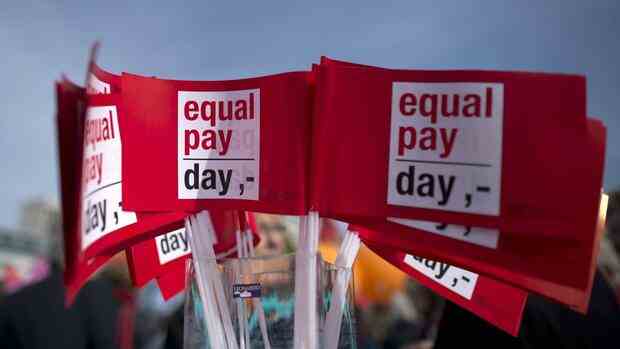Equal Pay Day, which falls on March 7 this year, symbolizes the pay gap. In theory, women work for free until that date, while men have been paid for their work since January 1st.
The symbolic day has clearly moved forward in the calendar over the years. Nevertheless, there is still a lot to do in terms of equality, emphasizes the head of the Federal Employment Agency (BA), Andrea Nahles. “If you consider that the first Equal Pay Day for Germany in 2009 was calculated for March 20th and this year falls on March 7th, then we are moving in the right direction,” said Nahles. “But we still have a long way to go.”
A large part of the wage gap can be explained by factors such as qualifications, career choice, industry or differences in working hours. In addition, male-dominated sectors, such as industrial sectors, earn more than women-dominated sectors such as health care or social and educational services.
However, a current study by the WSI research institute of the Hans Böckler Foundation, which is close to the union, also shows that women in 45 of the 46 sectors surveyed have lower hourly wages than men; they only earn slightly better in the postal services.
Women are less likely to be found in leadership positions
However, differences in earnings also have to do with the fact that women are still less likely to be promoted to well-paid management positions than their male colleagues. Although women make up almost half of the workforce, only 28 percent of employees with supervisory and management functions are female, criticizes BA boss Nahles.
If you divide all employees into ten equal groups based on their gross hourly earnings, then only 25 percent of the tenth of the top earners are women. According to the Federal Statistical Office, male top earners in particular are driving up the gender pay gap.
Adjusted wage gap is 7 percent
The adjusted gender pay gap, in which differences in qualifications, career choices or working hours are factored out, is currently seven percent. Researchers have also attributed part of this gap to the fact that men are more aggressive than women in salary negotiations. However, the Federal Labor Court ruled in mid-February that negotiating skills can no longer be used as a justification for unequal pay between men and women.
However, inequality in the labor market is not only caused by different earnings, but also has to do with labor force participation overall. The Federal Statistical Office has therefore developed the new indicator “Gender Gap Labor Market”. In addition to the earnings gap per hour, it also takes into account differences in the paid monthly working hours and the labor force participation of men and women.
Female employees work part-time almost three times as often as their male colleagues. In 2022, women worked an average of 121 hours per month, men 148 hours.
>> Read here: A part-time economy – weekly working hours are falling
Because of the high part-time rate, women in Germany spent 18 percent less time on paid work than men last year. From the age of 30.5 years – the age at which women on average become mothers – this gap increases almost steadily.
In addition, more men who are of working age work overall. In 2021, 72.1 percent of all women were in paid work, compared to 79.4 percent of men. From these two indicators and the gender pay gap, the Federal Statistical Office calculates a “gender gap on the labor market” of currently 39 percent.
Based on the most recent available comparative figures from 2018, when looking at hourly wages, working hours and labor force participation, only Austria, the Netherlands and Italy had more pronounced earnings inequality than Germany.
Hourly wages alone are not decisive
The example of Italy shows that different hourly wages are not the only decisive factor. There, the gender pay gap in 2018 was only five percent compared to 20 percent in Germany. However, because women are much less likely to be employed than men in Italy than in Germany, the gender gap in the labor market was 43 percent, one percentage point higher than in Germany.
There are many approaches to further closing the earnings gap. The WSI researchers propose an equality law for the private sector that would oblige companies to develop equality strategies.
The women’s policy spokeswoman for the FDP parliamentary group, Nicole Bauer, also points out that women spend an average of 52.4 percent more time than men on unpaid care work in the family every day. “In a country where women do 80 percent of the family care work, we have to ensure that women can better combine work and family,” demands Bauer. More flexible working time models, higher quality childcare and better all-day care are needed.
Bauer’s SPD colleague Leni Breymaier referred to the Pay Transparency Act, which is intended to reveal gender-specific pay differences. The law will be expanded in such a way that employees no longer have to assert their right to equal pay on their own, but can rely on associations, she announces.
More: That’s how different men and women are at the end of their working lives

